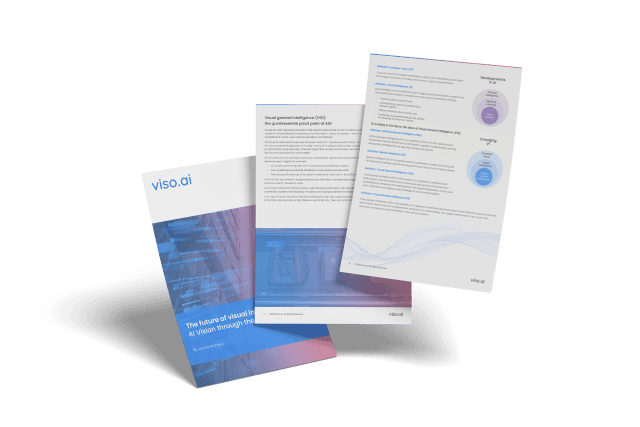This article draws insights from a recent webinar announcing the dawn of Visual General Intelligence (VGI). Hosted by viso.ai, the webinar featured Gaudenz Boesch and Nico Klingler (both co-founders and co-CEOs) and Jeremy Michaels (Strategic Content Writer). It was moderated by Chrissie Jamieson (Vice President Marketing).
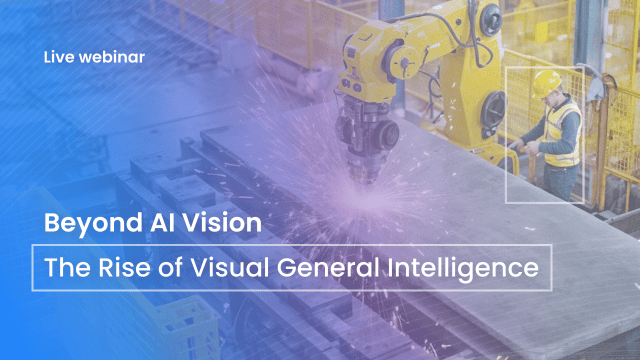
See more:
- VGI Whitepaper
- Official VGI Whitepaper Launch Interview
- Q&A with the Founders: Introducing VGI Webinar
Visual General Intelligence: the evolution from seeing to understanding
While AI Vision has already transformed industries, from manufacturing to construction, we stand at the threshold of something far more profound: Visual General Intelligence (VGI). This isn’t simply better computer vision: it’s the emergence of machines that understand, reason, and interact with visual environments at and then beyond the human level.
As Gaudenz explained during our recent webinar:
“VGI is Artificial Intelligence that possesses human-level visual cognition across all domains. Instead of being trained for specific tasks, it has general visual knowledge that it can apply to any scenario.”
This shift represents a fundamental leap from narrow, task-specific detection to general-purpose visual understanding that adapts across contexts and industries without requiring extensive retraining.
Below, we cover the implications and applications of VGI, as covered in the webinar, in more detail. You can also register for our whitepaper on the rise of VGI, from which these and further insights are drawn.

The $5 trillion opportunity hidden in plain sight
Current AI Vision systems excel at what they’re designed for, and they also offer far more than detecting missing hard hats, identifying defects on production lines, or flagging safety violations. At its core, computer vision enables machines to interpret and understand visual information, turning raw pixels into context and actionable insights.
This capability underpins applications across industries: ensuring safety and quality in manufacturing, tracking goods and optimizing supply chains, powering autonomous vehicles and traffic systems, assisting clinicians in healthcare, and enhancing customer experiences in retail.
These systems already represent visual intelligence in action – not as narrow point tools, but as a broad foundation for the next step: VGI, where specialized capabilities evolve into adaptive, human-like understanding. However, these systems today live in isolation, unable to connect dots across operational contexts or predict emerging risks.
As outlined in the webinar, VGI has the potential to change everything. McKinsey and PWC research suggests visual intelligence applications could add over 4% to global GDP annually as early as 2040: nearly $5 trillion in economic value in today’s terms. This conservative estimate doesn’t account for VGI’s truly limitless applications across every visual domain.
The economic case becomes clear when you consider the hidden costs of current approaches. Organizations typically deploy dozens of point solutions, each requiring separate training, maintenance, and integration. VGI consolidates this complexity into adaptive platforms that learn continuously and scale across use cases.

Six capabilities that define the Visual General Intelligence revolution
VGI is far more than improved computer vision – it represents six essential capabilities working together, as outlined here.
1. General visual knowledge enables understanding of objects, actions, environments, and materials across diverse domains without task-specific training. This is essential, meaning a VGI system recognizing safety violations in construction can immediately apply similar reasoning to other industries such as warehousing or manufacturing.
2. Goal-directed perception means systems can see with purpose, prioritizing relevant information based on specific objectives. Like human vision, VGI aligns processing with specific and defined desired outcomes rather than passively analyzing everything.
3. Context-aware understanding goes beyond static image analysis to comprehend scenes as part of dynamic, interconnected environments. VGI perceives relationships between objects, environmental conditions, and the roles of different agents within complex scenarios.
4. Visual agency enables action through perception loops, supporting autonomous responses, robotic manipulation, or direct integration with operational systems.
5. Continual visual learning allows systems to continuously update understanding based on new environments and tasks while retaining previously learned capabilities. They accumulate knowledge rather than forgetting past learning.
6. High-level visual cognition infers intent, causality, and predicts outcomes based on visual information. This anticipatory capability reads context and predicts hazards before they manifest.
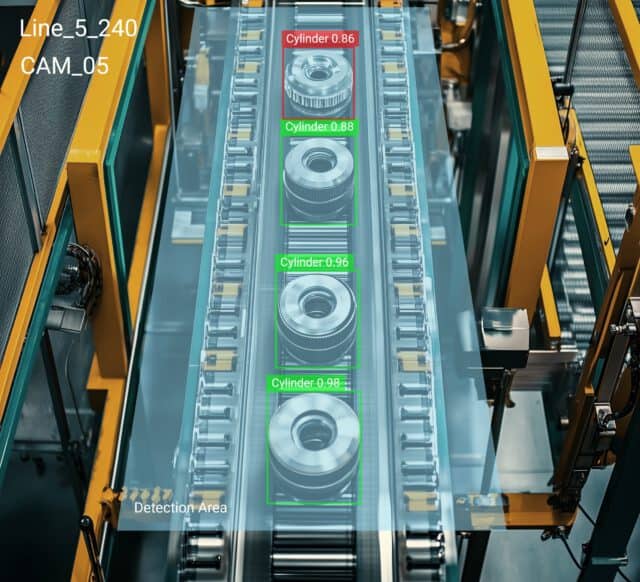
From detection to prediction: Visual General Intelligence in action
The practical applications of this next evolution of visual intelligence showcase VGI‘s transformative potential across industries.
1. In manufacturing, VGI will move beyond defect detection to predictive quality management. VGI observes subtle changes in operator behavior, environmental conditions, or equipment wear that precede quality issues. It connects visual observations to operational context, identifying that defect rates increase when certain operators work overtime or safety hazards correlate with shift changes.
2. Construction environments exemplify VGI’s adaptive capabilities. Unlike static detection systems, VGI understands that temporary scaffolding creates new hazard zones, recognizes when weather conditions require different safety protocols, and predicts high-risk periods based on crew fatigue patterns and environmental factors.
3. And logistics and warehousing will benefit from VGI’s ability to optimize picking routes in real-time based on current facility conditions, predict equipment maintenance needs before failures occur, and identify process improvements through behavioral analysis.
As Nico noted:
“VGI adapts in real-time. It understands that temporary scaffolding creates new hazard zones, recognizes when weather conditions require different safety protocols, and can predict high-risk periods based on crew fatigue patterns and environmental factors.”

The application layer: where intelligence becomes impact
The most powerful models remain theoretical without robust application layers. VGI‘s true value emerges when connected to cameras, edge hardware, human feedback loops, workflows, and dashboards that transform detection into action. This is where the all-important application layer comes in.
The integration of the application layer transforms isolated insights into strategic decision-making. Instead of receiving a long list of safety alerts, managers get connected intelligence that improves operational outcomes and makes compliance part of smarter, adaptive systems.
Modern VGI platforms will provide:
- Dynamic configuration tools enabling remote customization of detection zones, thresholds, and workflows
- Human-in-the-loop feedback mechanisms that turn user corrections into system improvements
- Edge computing architectures supporting real-time processing while ensuring privacy and reducing bandwidth requirements
- Integration capabilities connecting VGI insights directly into existing business processes and enterprise systems
The perfect storm driving Visual General Intelligence adoption
Three powerful converging forces are propelling VGI from laboratory concept to deployed reality, as below, driving VGI adoption.
1. Foundation model breakthroughs following text-based AI successes have enabled Large Vision Models that bring general-purpose capabilities to visual domains. These systems understand context and relationships rather than just pattern matching.
2. Hardware democratization has made high-performance processing affordable and accessible. Edge computing brings AI closer to data sources, solving latency and privacy challenges while enabling real-time analysis.
3. Data efficiency revolution reduces dependence on manual labeling through self-supervised learning and synthetic data generation. Modern approaches require dramatically less labelled data while achieving superior performance.
These technical advances combine with growing organizational readiness and accessible infrastructure to make VGI not just feasible, but imminently deployable.
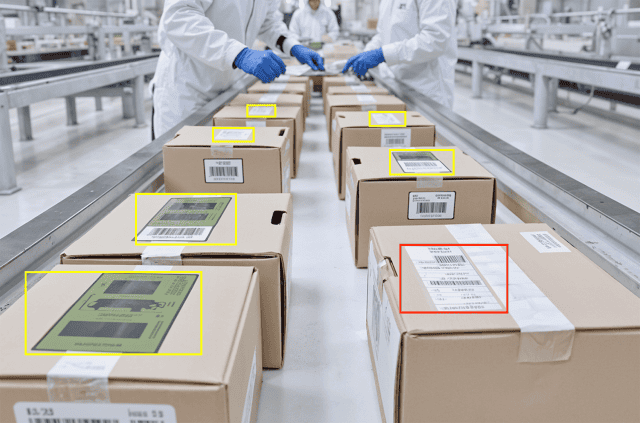
Overcoming implementation barriers for Visual General Intelligence
It’s a common misconception – as with many new technologies – that innovation brings with it technical barriers to implementation. The reality with AI Vision and VGI is that barriers are more people-based, cultural, conceptual, and intellectual.
As Gaudenz observed:
“The biggest obstacle to VGI adoption isn’t technical… It’s conceptual. Many organizations are still thinking in terms of narrow AI applications rather than general visual intelligence platforms.”
Successful VGI implementation requires:
- Strategic vision: understanding VGI as intelligent infrastructure rather than point solutions
- Incremental deployment: starting with pilot implementations that prove value quickly before scaling systematically
- Change management: building organizational competencies in visual intelligence deployment and management
- Privacy-by-design: implementing edge processing, anonymization, and compliance frameworks from the outset
- Privacy and trust: the foundation of sustainable Visual General Intelligence
Powerful visual intelligence demands robust ethical frameworks. Privacy-by-design approaches using edge processing minimize data transmission while object blurring ensures anonymization. GDPR compliance and security certifications provide additional assurance.
Most importantly, VGI succeeds when positioned as collaborative decision-support rather than surveillance. Transparency about system capabilities, data handling, and decision-making processes builds trust that enables adoption and effectiveness.
As Jeremy emphasized:
“VGI should serve people as an autonomous decision-support system. That’s why involving the workforce in building and operating it is essential. A privacy-by-design approach is the foundation of successful VGI.”
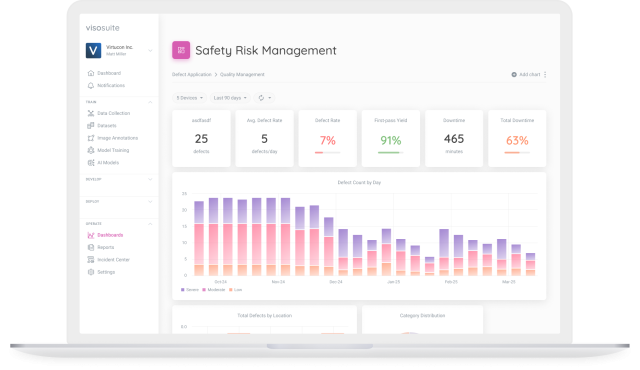
Getting started: your Visual General Intelligence roadmap
The roadmap to VGI is more tangible and simpler than you might think. Below, we outline the first four steps we would recommend to early adopters.
1. Map highest-impact use cases targeting safety, efficiency, or quality where visual intelligence offers immediate value. Focus on problems with clear, measurable outcomes.
2. Assess infrastructure readiness by reviewing camera systems, data availability, and organizational change capacity. Most deployments leverage existing CCTV installations.
3. Start small, scale fast with pilot implementations that can be operational within days. Proof-of-concept success creates momentum for broader adoption.
4. Build capabilities in VGI deployment and management. Technical capabilities will continue advancing – implementation excellence provides competitive differentiation.
VGI is more than just the next stage in computer vision – it is the bridge to a future where machines perceive, reason, and act with human-level understanding of the visual world. From manufacturing and logistics to healthcare and energy, VGI promises not just incremental improvements but a fundamental reshaping of how organizations ensure safety, efficiency, and innovation.
The leap from narrow, task-bound vision systems to adaptive, context-aware intelligence marks a milestone on the road toward Artificial General Intelligence (AGI) itself – and crucially, one that businesses can begin preparing for right now. The takeaway is clear: the future of AI will be won not by those who simply experiment with isolated use cases, but by those who build adaptive visual intelligence into the very fabric of their operations.
It is not a distant concept – it is an emerging reality, powered by accessible infrastructure, scalable platforms, and ethical frameworks designed for trust. And we see this moment as an inflection point: the chance to shape the future of human-machine collaboration, where vision becomes intelligence and intelligence becomes impact.
The opportunity is here – and it is truly limitless.
You can pre-register for our forthcoming whitepaper exploring the rise of VGI.

